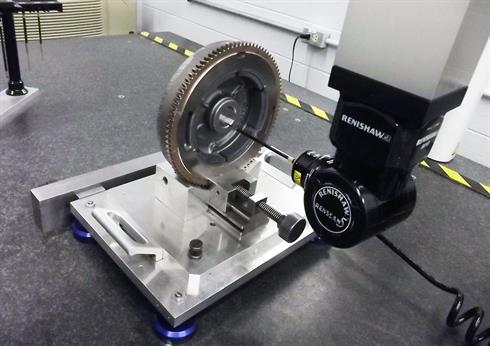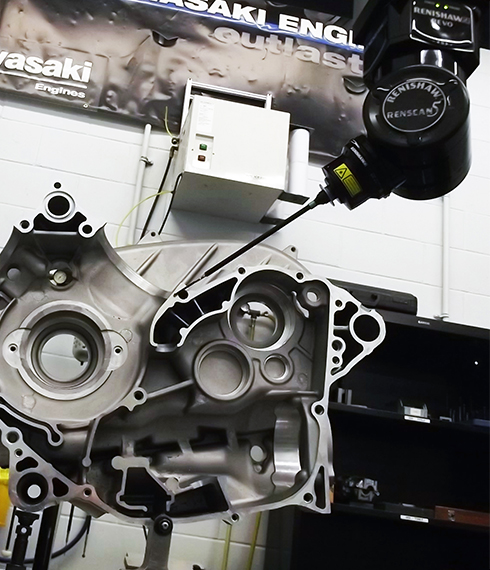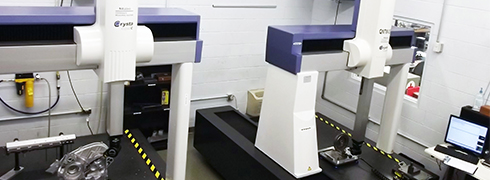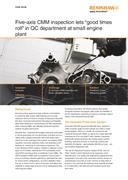Ta strona nie jest obecnie dostępna w Twoim języku. Możesz zapoznać się z tłumaczeniem automatycznym, korzystając z usługi Google Translate. Nie jesteśmy odpowiedzialni za świadczenie tej usługi, ani też wyniki tłumaczenia nie były przez nas sprawdzane.
Jeżeli chciałbyś uzyskać więcej pomocy skontaktuj się z nami.
Five-axis CMM inspection lets "good times roll"
Scanning probes speed form-data collection and feedback to machining cells, reduce CMM fixturing and cut probe calibration time from hours to minutes at Kawasaki's Maryville, MO plant. Increased measurement throughput and flexibility allow faster feedback to manufacturing and the R&D department, while scanning CMMs may ultimately eliminate inspection systems for gears and cam lift.
Kawasaki encourages motorcycle enthusiasts to "let the good times roll," but good times of another sort are rolling at the company's Maryville, MO small engine plant, where two 5-axis scanning probe systems are slashing CMM inspection and probe calibration times, and speeding up QC feedback for machining of small engine components. The 5-axis Renishaw REVO® systems, installed on Mitutoyo Crysta-Apex 121210 CMMs, replaced two PH10 articulating heads using SP25M scanning probes on traditional 3-axis CMMs. The REVO-equipped CMMs have cut inspection times by half or more on scanning intensive applications, eliminated the need for custom probe configurations, cut probe calibration times from six to seven hours to about 45 minutes, and added new capability to collect large amounts of form measurement data, improving part quality. Of primary importance, the REVO systems have greatly increased inspection throughput, data quality and flexibility of the QC department, enhancing its value as a strategic support asset to both manufacturing and R&D.

The Kawasaki Production System
Kawasaki's 800,000 square-foot Maryville plant, opened in 1989, produces single and twin-cylinder air-cooled or water-cooled engines, 1000 cc or smaller, for commercial and consumer lawnmower OEMs, as well as for a sister plant that manufactures ATVs and Mule™ utility vehicles. Operations at Maryville include aluminum die-casting, plastic injection molding, extensive amounts of machining, painting and assembly. All engines – approximately 500,000 per year – are run-off before shipping as well.
"We use the Kawasaki Production System (KPS)," said JC Watts, Quality Control Technical Group Supervisor at the Maryville plant. "Our quality and engineering requirements are comparable to the best in the automotive industry, though our manufacturing is focused on lower volumes of many different kinds of products." The plant has 50 machining lines, typically arranged in a U-cell pattern with start and end machines across from each other. "Primarily, it's one-piece production with machining lines running a part through multiple processes at a high rate," Watts explained. Kawasaki utilizes automation in many die cast and some machining operations, accomplished through the integration of Kawasaki robots. On one of the crankcase lines, robots load raw materials and unload finished parts that are placed into inventory for assembly to draw upon. Machined parts include aluminum, cast iron and steel.
"We're running similar tolerances that automotive powertrain uses for high-end products, and there are probably four or five critical processes for our aluminum parts and 15 for the steel parts," Watts added. It is not uncommon to find tolerances "in single digits in microns" for form, and 0.05 mm true position.
The QC lab is responsible for inspecting 125 different mass-produced parts, as well as vendor parts and those produced for engineering development. The environmentally controlled lab is located adjacent to the machining lines, and parts intended for routine inspection are delivered on carts or via train (an electric vehicle towing several trolley carts). Critical components may be hand delivered for priority inspection during a line changeover or if an operator suspects a problem.

5-axis scanning advantage
"When I started here, we had a couple of 3-axis CMMs with PH10 articulating heads and SP25 probes, and another CMM with a fixed probe head," Watts explained. "We were frustrated with having to make probe configurations and being limited to what we could do even with the articulated heads. We had so many different probe configurations that calibration times of six to seven hours took a bite out of our inspection throughput, too. We wanted to do better than what the industry considered the norm, so we looked at several options and the 5-axis REVO system appeared to be the fastest and most flexible available. It was the best fit for our requirements."
Kawasaki bought a new Mitutoyo Crysta-Apex 121210 in 2009 with the REVO system installed from the factory, and retrofitted an identical machine in 2010, after the first machine was up and running with all the part programs.
The REVO 5-axis scanning probe head can collect up to 6000 data points/sec. It is engineered for high-speed precision measurement of contoured surfaces and complex geometries requiring high-volume data collection to validate fit and form with high accuracy. It uses two rotary axes, one in the vertical plane and one in the horizontal, for infinite rotation and positioning. Five-axis software drives the measuring head and synchronizes its motion with the linear axes of the CMM. Look-ahead algorithms drive the probe path and CMM in coordinated continuous motion. The head adapts position while measuring on the move, maintaining stylus tip contact with changing contours at scanning speeds of up to 500 mm/sec.
"Though our SP25s were scanning probes, we were doing 95 percent touch probing because scanning was too slow with a 3-axis CMM," Watts explained. "Our cylinder and crank bores are probably the best examples of where we believed touch probing was inadequate. To accurately collect enough data points to measure the geometry of a bore 80 to 100 mm in diameter and 150 mm in length, the SP25 probe took so long we limited those inspections to machine set up or special requests from our design department. Now on every crank case we measure, the REVO does a spiral scan of bores and the system outputs the values to software. We also send a graph of the data points to our network that can be used by anyone in QC, engineering or production, and it really helps troubleshoot problems. You can VISUALIZE the problem. What would take 3-4 minutes with an SP25, we're measuring in 10 seconds with the REVO." The REVO scanning heads have all but eliminated the need for touch probing. Now 95 percent of inspections utilize scanning, with no "time penalty" as before, allowing Kawasaki to collect so much data that it challenges the speed of computers doing the analysis. The REVO probe can also do "head touch" probing or be used for traditional machine-touch probing when the situation calls for touches.
"With scanning inspections, our production and engineering people have a lot more confidence that the data is valid," Watts added. "With touch probing it is easy to get one speck of dirt that causes an out-of-round condition if you're only sampling seven or eight points. It can throw the location of that circle off. We have specific documented examples of where there were flatness errors we would not have caught with touch probing, and cylinder bore geometries that would not have been caught with touch probing because of the amount of data sampled with the touch probe. We still caught these problems before they left the plant, but the parts were scrap. The REVO scanning capability allows us to catch form errors much more quickly, without a time penalty on our inspections. It has definitely made us more proactive in catching quality problems early in the game."
The REVO scanning capability allows us to catch form errors much more quickly, without a time penalty on our inspections. It has definitely made us more proactive in catching quality problems early in the game.
Kawasaki (USA)
Fewer probe configurations, more flexibility
With REVO, the Maryville operation now has two probe configurations that measure all of its mass production parts, reserving custom probes in a changing rack for a few special applications. Special configurations for vendor parts have also been eliminated because the infinite positioning angles of REVO allow measuring of a part without special fixturing or consideration of which probe to use. With so few probes, calibration time has dropped to around 46 minutes. Now QC technicians monitor the calibration instead of calibrating every shift.
"We are now able to measure all our mass production parts with just two probe configurations," said Watts. "We were able to eliminate the large ball stylus configurations because of the large approach angle the REVO creates between the stylus and the work piece. During scanning the REVO maintains the approach angle which allows a large cylindrical feature such as a cylinder bore to be measured with the same stylus used for measuring a 5mm bore, with no chance of shanking the stylus."
Flexibility of the REVO system has also proven to be a time-saver for Kawasaki. "We can measure any part on either machine with a limited amount of fixturing and no special calibrations," said Watts. "We measure all our parts on three types of fixturing. The REVO probe orients itself to the part after it's initially aligned. The utilization of special fixtures has almost been eliminated, without concerns of measurement error due to part alignment."
Kawasaki programs all of its inspection routines in-house using Mitutoyo's Mcosmos 3.1 software. The upgrade to REVO instigated a shift to parametric and modular programming of inspection routines through in-house development of coding. This allows a program to be used for a part family. "We might have 30 different crankshafts, for example, but because everyone has the same features, only in a different size or location, we can use the same inspection program to measure all the parts," Watts stated. "That's one of the big advantages we gained." Infinite angles of the REVO system make it simple to create parametric programs because there is no concern about the stylus interfering with a part feature, due to size or orientation of the feature. The probe automatically aligns normal to the feature being measured, simplifying programming.

Faster inspection, better data from QC to R&D
Watts says the transition from 3-axis to 5-axis programming is not difficult, and a programmer with limited ability can still program REVO inspections as 3-axis. However, when it comes to optimizing speed of inspection, it is critical to use head motion as much as possible. "This allows you to scan parts the quickest, without inducing measurement error," he added. "REVO opens up a lot of possibilities, with few limitations, so speed gains are obtainable for both the higher and lower skilled programmers."
Inspection results may be relayed to the machining lines manually or they can be accessed locally by line operators over a computer network. "Some of our inspection reports supply offsets directly back to the machining centers coordinate system; this allows the CNC operator to read the offset adjustment right off the report, allowing no misinterpretation of what offsets the operator needs to input," Watts explained. "We take advantage of some of the 'best fit' algorithms and work with our production engineers, especially on parts that require more complex algorithms to get the adjustment right, and to utilize multiple process adjustments simultaneously. We had limited ability to do this before the REVO; the REVO allowed us to utilize parametric programming, which in turn allowed us to expand our capability across the board more easily."
Five-axis CMM scanning has been a game-changer for QC at the Maryville plant in terms of speed, data quality, and inspection capacity, according to Watts. "We've enjoyed big gains from having two machines that are completely redundant, so if one machine breaks or is down for calibration, it's no problem to measure critical parts on the other machine. That's a big advantage in the QC lab, because we were the ones who, in a pinch, had to get the large part on the small CMM, or the part requiring the odd angle probe on the machine that didn't have it. We used to get requests from R&D to measure certain geometries, and it was next to impossible to achieve in the time allotted. Now we can provide the data much quicker and, being scanned data, our people have greater confidence in it. This new flexibility, the reduced fixturing, form measurement, the parametric programming – these are all collateral advantages, in addition to the raw inspection speed."
The Maryville facility has run more than 50,000 parts through the two REVO equipped CMMs, and Watts indicated there are plans to expand the use of the REVO system to gear inspection and cam lift if it proves feasible. "We've developed our own algorithm and sub-routine in our software for cam lift, and, that's something that would have been more difficult to do without the REVO system due to the angle the probe requires to measure the lift on the lobes."

